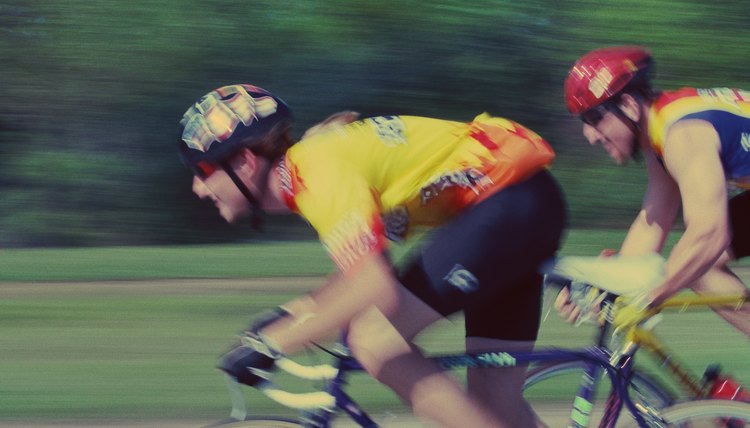Calories Burned With the Ironman

To say covering 140.6 miles by swimming, biking and running takes a lot of energy is an understatement. Racing an Ironman triathlon takes between eight and 17 hours of steady, aerobic work. How many calories you burn depends on your finish time, intensity level, size and efficiency at each of the sports.
Swimming
An Ironman swim consists of 2.4 miles in a reservoir, lake or ocean. Professional triathletes complete this distance in less than an hour, while the average racer takes between 60 and 90 minutes. Vigorous swimming, as you would do in a race, burns about 372 calories per hour for a 155-pound person. The less you weigh, the fewer calories you burn -- a 125-pound person burns 300 calories per hour swimming vigorously. The more you weigh, the more calories you burn -- a 185-pound person burns 444 calories per hour. The swim segment makes up the least of the calorie burn for the race because it is the shortest portion and requires less effort than biking and running.
Biking
The bike portion of an Ironman race is 112 miles and can take between five and eight hours. A 155-pound person burns 446 calories per hour going 16 to 19 mph. This means you're out on the bike for 6 1/2 to 7 hours, and burn close to 4,500 calories. Go faster than 20 mph and burn 614 calories per hour. At this pace, you'll finish the bike portion in just over 5 1/2 hours for a total burn of 3,500 calories. A 125-pound person would burn about 2,700 calories and a 185-pound person would burn 4,300 calories going at the same aggressive sub six-hour pace.
Running
The final event in an Ironman is a full marathon -- or 26.2 miles of running. Pros complete the marathon in less than 3 hours -- which means they are running about seven-minute miles. At this pace, a 155-pound person burns 539 calories per hour -- or a total of about 1,600 calories for the run. A 125-pound person burns about 1,300 calories while a 185-pound person burns about 1,800 calories going the same pace. The average triathlete takes between four and six hours to run the distance and is going between a 10- and 12-minute-per-mile pace. This pace burns fewer calories per hour, but you are out on the course for longer. Go 11.5 mph, which has you finishing the marathon in five hours, and burn 335 calories per hour or 1,635 for the run portion of the race if you weigh 155 pounds. A 185-pound athlete burns about 2,000 calories in five hours while a 125-pound athlete burns 1,350.
Total
Put all the sports together and you'll burn 7,000 calories or more during the course of the race. An elite athlete racing at the most aggressive paces in all three sports and finishing in eight to nine hours could burn 8,000 to 10,000 calories. You will need to replace some of these calories with nutrition on the course. Ironman events offer sports drinks, gels, chews, bars, fruit and other food that is easy to digest. How much you need to eat during each event really depends on your body's ability to process the calories and your ability to use stored fat as fuel. Practice refueling during long training sessions so you know what works for you on race day. Never try a new food or fueling routine on race day or risk gastric distress or bonking -- complete, fatigue from which you can't recover.
References
- Harvard Health Publications: Calories Burned During Different Activities for People of Three Different Weights
- Run Tri: How Much Time Does it Take to Finish an Ironman Triathlon? Average Ironman Finish Times
- Endurance Corner: Ironman Race Nutrition
- Metabolic Efficiency Training; Bob Seebohar
- Training Plans for MultiSport Athletes; Gale Bernhardt
Writer Bio
Andrea Cespedes is a professionally trained chef who has focused studies in nutrition. With more than 20 years of experience in the fitness industry, she coaches cycling and running and teaches Pilates and yoga. She is an American Council on Exercise-certified personal trainer, RYT-200 and has degrees from Princeton and Columbia University.
